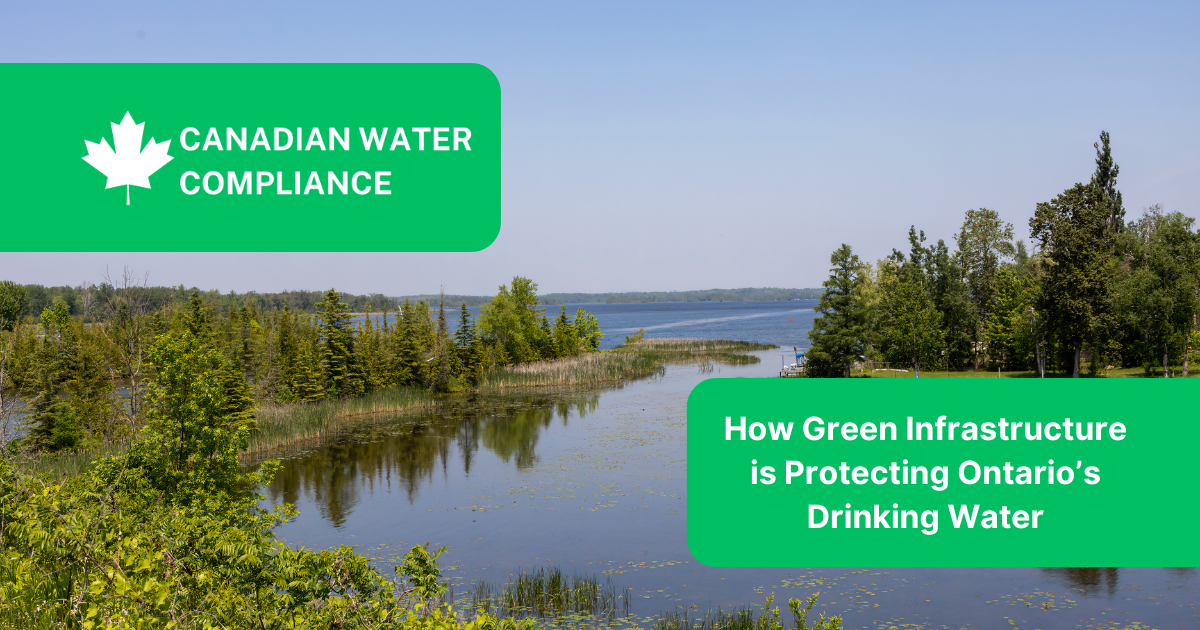
Written By: Canadian Water Compliance | On
As Ontario’s population grows and urban areas expand, water pollution, stormwater runoff, and groundwater depletion have become major concerns. Traditional gray infrastructure (concrete storm drains, pipes, and treatment plants) helps manage water, but it often fails to address pollution at the source.
Enter green infrastructure—a sustainable approach that uses natural systems to manage water, reduce contamination, and improve drinking water quality. By incorporating wetlands, rain gardens, permeable surfaces, and green roofs, Ontario can better protect its lakes, rivers, and groundwater sources.
✅ What green infrastructure is and how it works
✅ How it improves water quality and reduces pollution
✅ Examples of green infrastructure projects in Ontario
✅ How businesses and homeowners can implement green solutions
Green infrastructure (GI) refers to natural and engineered systems that help manage rainwater, reduce flooding, and protect water quality. Unlike traditional gray infrastructure, which moves water away quickly, green solutions absorb, filter, and store water where it falls.
🌱 Wetlands & Naturalized Stormwater Ponds – Filter out contaminants before water reaches lakes and rivers.
🌿 Rain Gardens & Bioswales – Use plants and soil to absorb stormwater and remove pollutants.
🏠 Green Roofs & Living Walls – Reduce runoff by absorbing rainwater on rooftops.
🛣 Permeable Pavement – Allows rainwater to soak into the ground instead of overwhelming storm drains.
🌳 Urban Tree Canopies – Slow down rainwater, reducing erosion and runoff.
📌 Why It Matters: Ontario’s cities struggle with stormwater runoff, which can carry road salt, oil, fertilizers, and bacteria into drinking water sources. Green infrastructure helps reduce these contaminants before they reach our water supply.
🚰 Reduces Contaminant Runoff
Traditional storm drains send untreated runoff (car oil, heavy metals, pesticides, and bacteria) directly into lakes and rivers. Green infrastructure filters pollutants before they enter drinking water supplies.
🌊 Prevents Sewage Overflows
Ontario’s older cities use combined sewer systems, where heavy rains can cause raw sewage to overflow into rivers. Green infrastructure reduces the strain on wastewater systems, lowering the risk of contamination.
💧 Recharges Groundwater & Prevents Droughts
Impermeable surfaces (roads, sidewalks, and parking lots) prevent rain from soaking into the ground, leading to declining groundwater levels. Green infrastructure helps restore aquifers, keeping wells and water sources sustainable.
🔥 Reduces the Impact of Extreme Weather
With climate change increasing heavy rainfall and flooding, green infrastructure absorbs excess water naturally, preventing erosion and protecting drinking water sources.
📌 Example: In 2023, Ontario’s Conservation Authorities reported that wetland restoration projects reduced flood risks by 30% and improved water quality in Lake Ontario tributaries.
Several Ontario cities and organizations are already using green infrastructure to protect water quality:
Toronto requires new commercial buildings to include green roofs, reducing stormwater runoff and heat absorption. This helps filter pollutants before they reach Lake Ontario.
The Don River has historically faced high levels of sewage overflows and pollution. Green infrastructure projects, including wetland restoration and rain gardens, are helping to improve water quality.
Lake Simcoe’s water quality is at risk due to phosphorus runoff from urban areas and farms. The province is investing in buffer strips, bioswales, and wetland restoration to reduce nutrient pollution.
Farmers in Ontario are using cover crops, buffer strips, and constructed wetlands to filter runoff and reduce nutrient pollution in groundwater.
You don’t need to be a city planner to benefit from green infrastructure—small-scale changes at home or at work can improve water quality and reduce flood risks.
✔ Install a Rain Garden – Absorbs rainwater and prevents pollutants from entering storm drains.
✔ Use Permeable Driveways – Allows water to soak into the ground instead of running off into sewers.
✔ Plant Native Trees & Shrubs – Helps filter and slow down runoff.
✔ Reduce Fertilizer Use – Prevents excess phosphorus from contaminating water sources.
✔ Install a Green Roof – Reduces runoff and helps cool buildings.
✔ Use Stormwater Capture Systems – Collects rainwater for irrigation, reducing strain on municipal supplies.
✔ Develop Naturalized Landscapes – Replaces lawns with native plants to reduce runoff and filter contaminants.
📌 Bonus: Many Ontario municipalities offer rebates and incentives for green infrastructure projects!
As water quality challenges grow, Ontario is investing in nature-based solutions to keep drinking water clean. The Ontario Green Infrastructure Coalition is advocating for more:
✅ Wetland protection & expansion
✅ Green building requirements for stormwater management
✅ Municipal incentives for green roofs, bioswales, and permeable pavement
📌 Example: The City of Ottawa recently invested $1.5 million in green infrastructure projects to improve stormwater management and reduce contaminants entering the Rideau River.
Green infrastructure is a proven, sustainable solution for protecting Ontario’s drinking water. By reducing pollution, managing stormwater naturally, and replenishing groundwater, these methods help cities, businesses, and homeowners keep water sources safe.
✔ Green infrastructure helps filter pollutants, prevent sewage overflows, and improve water quality.
✔ Ontario cities like Toronto, Ottawa, and Lake Simcoe are leading the way in green infrastructure projects.
✔ Homeowners & businesses can implement small-scale green solutions to reduce runoff and protect drinking water.
✔ More investment is needed to scale up green infrastructure efforts in Ontario.
🔎 Interested in protecting your water supply? Contact Canadian Water Compliance for expert water testing and treatment solutions!